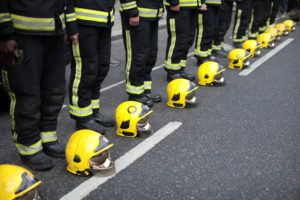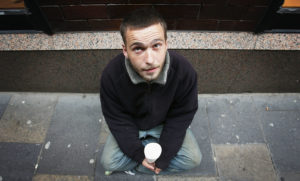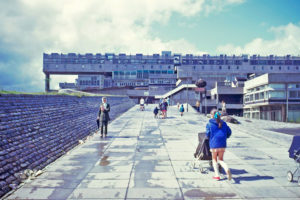Underneath the Westway flyover, in the shadow of Grenfell Tower, is the much-loved community hub, the Maxilla Social Club. Following the devastation of the Grenfell fire, in June 2017, which claimed the lives of 72 people, it became a collection point for donations. I was there this week, watching Dictating to the Estate, a harrowing play drawn completely from official documents and testimonies.
The picture built up by Nathaniel McBride’s documentary drama is one of unremitting institutional failure on the part of the local authority and the quango responsible for housing in the borough. The well-documented failures of fire safety in the years running up to the tragedy date as far back as 2010, when the ventilation system was exposed as not good enough after a fire melted a front door.
In 2013, Grenfell residents experienced a night of power surges and the threat of a serious fire when laptops and computers in some of the flats “literally exploded”. Their desperately concerned emails to the council were met with denials of responsibility and claims that no one else had reported such occurrences.
In 2015, the infamous contractor Rydon was tasked with refurbishing the tower, installing the flammable cladding, new boilers, and defective windows. This is when the pivotal decision was taken by the Kensington & Chelsea Tenants Management Organisation (KCTMO) to switch from fire resistant zinc cladding to the cheaper, but lethal, aluminium, to cut costs. Shockingly, a test on the safety of the cladding was performed but discontinued because it was deemed too dangerous.
A year later, the KCTMO carried out its own very positive review of the work they had commissioned; but in April 2017, just three months before the fire, the Fire Brigade warned that the building facades were not compliant with health and safety regulations. Over in Westminster, David Cameron’s promise to wage war on excessive health and safety set the tone. “We need to realise, collectively, that we cannot eliminate risk and that some accidents are inevitable,” the former prime minister said. The late David Amess, the chair of the All-Party Parliamentary Group on fire safety regulations asked for fire regulations to be reviewed a heroic 13 times, but his calls fell on deaf ears.
The two questions running through the play are: why did Grenfell fire happen, and could it happen again? The Government’s Grenfell Tower Inquiry is making it very clear that there were many instances of specific failure related to fire safety and building regulations. There is relief that there is now a ban on combustible cladding on tall buildings but that is set against the difficulties of achieving that ban, with the Government initially resistant to it.
And while mitigating steps relating to cladding have been taken, other significant risks remain. There are serious concerns about lightweight timber frame construction, while the UK remains an international outlier by continuing to permit single staircases in tall buildings. Peter Apps, the deputy editor of Inside Housing, believes there are hundreds of thousands of buildings which have similar levels of risk to Grenfell and warns that “we are drifting back to the same attitudes”.
These are the specifics, but the broader question relates to democratic accountability and the failure to listen to residents’ repeated concerns about safety. In a horrifyingly prescient blog post written just months before the fire, the Grenfell Action Group stated: “It is a truly terrifying thought but the Grenfell Action Group firmly believe that only a catastrophic event will expose the ineptitude and incompetence of our landlord, the KCTMO, and bring to an end the dangerous living conditions and neglect of health and safety legislation.”
The correspondence between the council and the KCTMO reveals the casual contempt with which residents’ concerns were treated. Residents claimed that they were not given the opportunity to comment on the refurbishment and during the works repeatedly said they faced intimidation and harassment by Rydon and the KCTMO, including abusive emails. During this time, one of the residents reporting intimidation was implicitly threatened with eviction when he found out that he was being investigated by the council for the “unclear circumstances” through which he had inherited his tenancy agreement.
Where contrition might have been expected, astonishingly the same attitude to residents continued after the fire, when the contracts manager for Rydon told the government’s Inquiry that residents who raised complaints about fire safety and cladding were “vocal and aggressive” and “regardless of what work was being carried out would still have found a reason to complain”.
But the complete breakdown of relations between community and local authority is not limited to what happened at Grenfell. It is replicated in many other London boroughs where both homeowners and social housing tenants on housing estates find it impossible to communicate with their councils. In Southwark, a homeowner on the Aylesbury Estate who was opposed to the regeneration of the estate found herself with no electricity, no internet access, no lift services and no hot water or heating, while the postman was told nobody lived at her address. Beverley Robinson, chair of the Aylesbury Leaseholders Action Group, recalled: “I had no heating for weeks and weeks and then they wouldn’t let the people in to fix it.”
Loretta Lees, Professor of Human Geography at Leicester University and former Chair of the London Housing Panel, describes this trend towards open conflict between local authorities and housing estate residents as reflecting the “Rachman-like tendencies” of the state. Peter Rachman was a slum landlord who operated in Notting Hill in the Fifties and Sixties and who became notorious for the exploitation and intimidation of his tenants who lived in terrible conditions.
The bigger picture is that all over London, and in many other cities, residents are failing to benefit from the wholesale regeneration and reconfiguration of their areas. Entire districts are witnessing the demolition of estates, which are replaced by ubiquitous developments of luxury apartments. In Elephant and Castle, the Heygate Estate was demolished and replaced by Elephant Park where two-bedroom apartments are on sale for more than £1 million. Roughly 25% of the scheme is designated affordable housing but as the definition of affordable housing has been changed to mean up to 80% of market value, that is far from affordable for the majority of Londoners.
The refurbishment of Grenfell Tower was also part of an area-wide regeneration, laid out in the “Notting Barns Masterplan”, which planned to create “a more successful urban neighbourhood through selective demolition of existing housing stock and the provision of high-quality new homes”. The aim was to drive up land values in the area by making it a more attractive place to live, which is regeneration speak for increasing property prices. The project also included the demolition of the neighbouring Silchester Estate, the leasing of the local library to the £22,000-per-year Notting Hill Prep School and the replacement of a popular community facility, the West London Stables, with luxury apartments, all of which aroused community opposition.
On the morning of the fire, a features editor emailed me to ask if I would write a piece “on the housing apartheid in London, how London’s poor end up living in death trap towers”. The narrative of poverty-stricken deprivation in a tower block ghetto, a stone’s throw from one of the richest parts of London, persisted throughout the media in the weeks after the disaster, with newspapers running with the need to demolish more social housing like this. It was only through the sheer level of interest in the story that it became clear that Grenfell had not only been structurally sound, but a much-loved place to live with a thriving and mixed community.
When the Government announced its Inquiry into the fire, the local community were disappointed by its limited scope, and demanded that it be widened, to “seek to understand how residents’ voices have been systematically ignored for so long”. Michael Mansfield QC, who is representing survivors and relatives, has highlighted that the Inquiry is only investigating how the fire came about and who should be accountable, rather than looking at the experience of living in social housing. He has pointed out that while the experience of living in social housing is crucial to what happened at Grenfell, it is “off limits”, with families given very limited opportunities to speak or ask questions. The consequence is that they feel excluded from the Inquiry, raising uncomfortable parallels with the reality of living in social housing.
The Inquiry is producing invaluable evidence about what happened and why, which means the likelihood of another incident related to the specific failures uncovered seems unlikely. But the broader question of elected councils listening to residents who voice uncomfortable truths has escaped scrutiny. This means that the next time concerns around potentially fatal issues are raised, there is still no certainty they will be listened to.
Governments of all stripes have long talked about the need to create mixed communities. Grenfell was a successful mixed community which found itself labelled as a ghetto, as part of a narrative of managed decline perpetuated by the institutions which wanted to regenerate the area. This is the end result of treating housing simply as financial asset, which combined with a complete failure to listen to the voices of the community, led to the tragedy of the fire.
Disclaimer
Some of the posts we share are controversial and we do not necessarily agree with them in the whole extend. Sometimes we agree with the content or part of it but we do not agree with the narration or language. Nevertheless we find them somehow interesting, valuable and/or informative or we share them, because we strongly believe in freedom of speech, free press and journalism. We strongly encourage you to have a critical approach to all the content, do your own research and analysis to build your own opinion.
We would be glad to have your feedback.
Source: UnHerd Read the original article here: https://unherd.com




